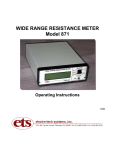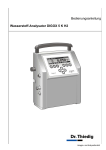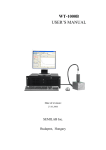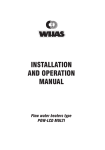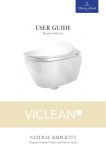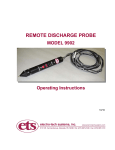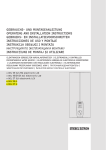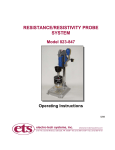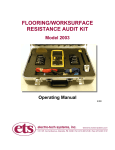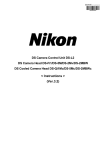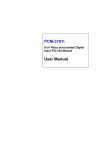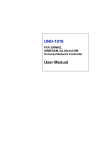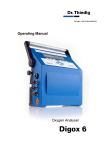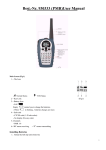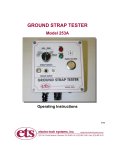Download MODEL 832 CLAMP ELECTRODES USER MANUAL
Transcript
MODEL 832 CLAMP ELECTRODES USER MANUAL 1.0 GENERAL DESCRIPTION The Model 832 Clamp Electrode Assembly is designed to test tubes, valves and other planar and non-planar objects such as IC Shipping Tubes and automotive fuel line components and assemblies in accordance with current and proposed industry specifications requiring resistance and/or static dissipation measurements. The probes feature a unique dual-pad design capable of measuring point-to-point, point-to-ground, volume resistance/resistivity and static dissipation. The Model 832 meets the electrode configuration specified for measuring the resistance of fuel line components and assemblies in accordance with SAE J1645 (versions dated 9/03 or later). The electrodes are designed to be used with resistance meters having test voltages of 10 and 100 volts such as the ETS Models 880 and 872 (shown below) or the Models 871 and 863-6487. When connected to the detector plate of a charged plate monitor such as the ETS Model 204 Charge Plated Analyzer, the electrodes enable the user to measure dissipation time from 1kV to 100 volts, in accordance with SAE J1645. Model 880 Model 872 2.0 ELECTRODE DESCRIPTION The Model 832 electrode assembly consists of one .25” square (6mm) and one .25”x.125” (6x3mm) conductive elastomer pads with volume resistivity of 0.08 ohmcm and Shore-A hardness of 65 durometer. The pads are mounted to stainless 1 steel electrodes that in turn are mounted to an insulated clamp exerting approximately 10 pounds (4.5kg) of force. The smaller electrode is designed to be inserted up to 1” (25mm) into a .25” (6mm) diameter tube such as those used in standard fuel system fittings and tubing or a .125” x .125” (3x3mm) slot. When measuring surface resistance the .25” (6mm) square pad is typically used. When measuring volume resistance both pads are used. Volume resistively in Ωcm, if required, is calculated using the area of the smaller pad, (0.18 sq. cm). Standard .162” (4mm) banana jacks are located at the end of each handle. The BLACK jack connects to the .25” sq. (6mm) electrode and the RED jack connects to the .25x.125” (6x3mm) electrode. Red and Black cables 30” (61cm) long, terminated with banana plugs are supplied with each pair of Electrodes. Standard cables with banana plugs supplied with most resistance meters are also satisfactory for the resistance measurements. NOTE: For static dissipation measurements, the supplied cables should be used because the higher insulation resistance of these cables will reduce secondary leakage paths. 3.0 USING THE ELECTRODES 3.1 Material Characteristics Loaded, thermoformed plastics consist of plastic resin filler with very high resistance properties loaded with a small percentage of a conductive material such as stainless steel fibers, carbon powder or fibers. When molded, these parts exhibit either conductive or static dissipative properties as defined in the ESD Association ADV1.0: Glossary of Terms. These materials have bulk resistance properties verses the surface only resistance properties found in other ESD materials. When a voltage is applied either across or through the material the dielectric of the filler breaks down and current flows from particle to particle. As the loading of the conductive medium decreases, there is greater distance between particles that in turn requires a higher voltage to break down the increased dielectric. At some point, once a higher voltage is applied to establish continuity the resistance of the path created may become altered permanently. Loaded thermoplastic materials are effective in reducing the upper resistance limit to approximately 108 Ohms. Another characteristic associated with loaded thermoplastic materials that affects resistance measurements is the microscopic insulative layer that develops on the surface of the molded part. The dielectric of this layer must 2 be broken down before a resistance measurement can be made. Once this occurs the actual resistance of the part may be lower than the measuring range of the instrumentation used. In essence, these materials are non-linear and voltage dependent. Hence, different test voltages will give different results. Even the series resistor incorporated in virtually all resistance meters are different from meter to meter which will cause variations in the measurements. Loaded thermoelectric material is generally not adversely affected by humidity, as long as it is reasonable such as less than 75% R.H. Currently, ESD materials are classified as follows: Conductive Surface Resistance * Volume Resistance * <104 Ω Dissipative Insulative 104 to <1011 Ω same ≥1011 Ω * The above ranges are resistance in ohms (Ω) not resistivity in ohms/sq. (Ω/sq.) Materials with bulk resistance characteristics can also be classified by specifying its volume resistivity. This is simply done by multiplying the measured resistance by the area of the measuring electrode or material surface, whichever is smaller, and divided by the thickness. ρv = A/t Rm Ω-cm All values are in cm giving a volume resistivity in Ohms-cm. To convert to Ohms-meter, multiply by 100. Increasing or decreasing the thickness of the material will also change the actual resistance of the part with a specified volume resistivity. This is a common technique used for ESD products to achieve a particular resistance. It is the actual resistance of the part, not its resistivity that determines how a part dissipates a static charge. While volume resistance or resistivity is most appropriate to classify a bulk conductive material it is the measured resistance across or through the affected surface to ground that is used to determine the ability of material to dissipate a static charge. While the resistance classifications were developed for ESD packaging materials, most specifications referencing resistance/resistivity for materials 3 used in hazardous locations usually specify resistance limits that fall within the Conductive range. Finally, it should be noted that the resistance/resistivity property of material does not predict whether the material will be low charging (antistatic) or not. 3.2 Measuring Resistance Prior to use, the calibration of the test apparatus should be checked. Plug the cables from the resistance meter into the BLACK banana jacks of the Model 832. Clamp the electrodes across a 1 kohm and a 10 megohm, 1% resistors. Measure the resistance using both 10 and 100 volts. The resistors are not included with the clamp electrodes. Whenever the electrostatic characteristics of materials are measured the temperature and relative humidity at the time of measurement should be recorded. Many materials are humidity dependent. Measurements taken at different RH levels may result in a significant variation in the measurements. The following recommended test procedure was developed for testing automotive fuel system components and assemblies. The same procedure can also be applied to just about any desired point-point, point-ground and volume resistance measurement. 1. Place the component or assembly being measured on a surface having a surface resistance at least two orders of magnitude higher than the upper resistance limit (>1x109 Ohms). 2. Verify the test set up by clamping the electrodes to a 1 kohm and a 10 Megohm, 1% resistor and measure at both 10 and 100 Volts. 3 For surface measurements, both clamps are required. Clamp both Clamp Electrodes on to the surface with the .25” sq. (6mm) contacts spaced apart at a desired distance on the surface to be measured. If the area is too small then use the smaller contact. For tubing place the .25”x.125” (6x3mm) contact inside the tube. In all cases, make sure the contact electrode sits flat and makes maximum surface contact with the part. If the part has a metal ground strap take measurements at both the point on the plastic part where the ground strap is attached and at the point on the strap where the strap is connected to the ground point. If using the .25” (6mm) contacts then connect the resistance meter to the BLACK jack on each Electrode. If using the .125” (6x3mm) contacts connect the resistance meter to the RED jacks 4. If the resistance meter being used allows manual selection of the test voltage, select 10 Volts. 4 Apply the voltage for 5 seconds or until a consistent reading is obtained, then take and record the reading. If the reading is unstable, record the reading as “unstable”. Select 100 Volts. Apply as above and record the reading. The lower the measured resistance, the smaller the differential between the 10 and 100 Volt readings should be. In most cases a product is considered acceptable if either the 10 Volt or the 100 Volt resistance reading is within the specified limits. Note: A measured resistance may be unstable at 10 Volts, but stable and within the specified limit at 100 Volts. On the other hand, the resistance may be below the measurement capability of the instrument at 100 Volts. It is also possible the resistance is below the measurement capability of the instrument at 10 Volts. In either case, record that the measured resistance is less than the measurement capability of the instrument (ex: <103 Ohms). The part would be considered acceptable. If actual low resistance measurements are required then use appropriate instrumentation and test voltage to obtain the reading. 5. 3.3 To measure volume resistance, connect the resistance meter to both the BLACK and RED jacks of a single Clamp Electrode and clamp it to the part to be measured.. Follow the measurement procedure above. To calculate volume resistively, multiply the measured resistance by the area of the small contact divided by the thickness of the material in cm (refer to Section 3.1). Static Dissipation This test measures the ability of a material or assembly to dissipate a charge using the measured resistance path. 1. Prepare the samples to be tested in the same manner as for measuring resistance. 2. Verify the test set up by measuring the dissipation time for a 10 megohm, 1% resistor. Connect the desired contact electrode to the Charge Plate Monitor detector plate and the resistor as shown in Figure 1. Connect the other electrode to ground such as the ground connection at the wall outlet. If a battery powered CPM is used make sure it is also connected to ground. Leave the grounding clamp unconnected 5 Figure 1 Set the measurement parameters for a 1000 Volt charge. NOTE: The actual charging voltage is approximately 1100-1200 Volts or more, but the decay time measurement starts when the voltage on the part reaches 1000 Volts and stops at the 10% (100 Volt) cut off. Apply the charging voltage for approximately 2 seconds. Release the Charge button and quickly connect the grounded electrode to the resistor. Repeat the measurement 3 times. Record the dissipation times. All readings should be ≤0.20 seconds or the minimum capability of the CPM. If the instrumentation includes a grounding relay module then connect the green wire to the wall outlet and plug the cable from the grounding electrode into the module and clamp the electrode to the other resistor lead. Charge the system as above then depress the “GROUND” pushbutton and record the reading. All readings should be ≤0.20 seconds. NOTE: Do not use the grounding function of the CPM to perform this test. This function only grounds the detector plate. 3. Connect the electrodes to the assembly Place the assembly on a highly insulative surface (>1012 Ohms/sq.) such as acrylic, Teflon™, polycarbonate etc. to ensure there is no secondary leakage path for the applied charging voltage to bleed off. 6 Figure 2 4. Apply the charging voltage for approximately 2 seconds. Immediately ground the assembly by clamping the grounded electrode to the desired point. Repeat the measurement 3 times and record the results. If the grounding module is utilized as shown in Figures 2 and 3, follow the same procedure described for system verification. Figure 3 7 4.0 TEST RESULTS The above test procedures were used to measure the resistance of automotive fuel system components and assemblies, and static dissipation of assemblies. Two different test instruments were used for each procedure. The results are as follows: Part Resistance-Ohms Dr. Thiedig Milli-TO-2 @10V @100V Dissipation ETS 872 @10V EA3 @100V Sec ETS 204 Sec 10 Meg Resistor 1.0 Meg 9.96 Meg 9.9 Meg 1.0 Meg 0.13* 0.5* Fuel Filter Assy. Hose-Hose (L) Hose-Gnd Pt. Hose-Gnd Strap 5.0 Meg 1.1 Meg 2.2 Gig 1.6 Meg <1 Meg 8.1 Meg 4.7 Meg 330 Kilo 1.9 Gig 2.0 Meg 180 Kilo 25 Meg 0.13 0.13 0.13 0.5 0.5 0.5 Fuel Filter 140 Meg Turn Electrodes 90° 22 Meg 23 Meg 24 Kilo 3.5 Meg 120 Kilo 0.13 0.5 Hose w/Conn. >1 Gig >1 Terra >1 Terra >1 Terra 10” Coated Tube >1 Gig >1 Terra >1 Terra >1 Terra Elbow Conn. <1 Kilo <1 Meg 180 <10 Kilo Test Strips PPS-1 PPS-2 PPS-3 POM-1 POM-2 POM-3 POM-4 1.1 Kilo <1 Kilo <1 Kilo 1.4 Gig u/s** 23 Meg u/s 5.5 Meg u/s 680 Meg u/s <1 Meg <1 Meg <1 Meg 1.1 Meg 420 Kilo <1 Meg 7.4 Meg 2.2 Kilo 4.2 Kilo 8.0 Kilo 310 Meg 2.8 Gig 350 Kilo u/s 2.5 Gig <10 Kilo <10 Kilo <10 Kilo 13 Meg 13 Meg <10 Meg 60 Meg Notes: * Dissipation times are the fastest times each CPM can measure ** u/s denotes an unstable resistance measurement Kilo = 103 Meg = 106 Gig = 109 Terra = 1012 Rev 1: 1/15/08 8 5.0 WARRANTY Electro-Tech Systems, Inc. warrants its equipment, accessories and parts of its manufacture to be and remain free from defects in material and workmanship for a period of one (1) year from date of invoice and will, at the discretion of Seller, either replace or repair without charge, F.O.B. Glenside, similar equipment or similar part to replace any equipment or part of its manufacture which, within the above stated time, is proved to have been defective at the time it was sold. All equipment claimed defective must be returned properly identified to the Seller (or presented to one of its agents for inspection). This warranty only applies to equipment operated in accordance with Seller’s operating instructions. Seller’s warranty with respect to those parts of the equipment which are purchased from other manufacturers shall be subject only to that manufacturer’s warranty. The Seller’s liability hereunder is expressly limited to repairing or replacing any parts of the equipment manufactured by the manufacturer and found to have been defective. The Seller shall not be liable for damage resulting or claimed to result from any cause whatsoever. The warranty becomes null and void should the equipment, or any part thereof, be abused or modified by the customer or if used in any application other than that for which it was intended. This warranty to replace or repair is the only warranty, either expressed or implied or provided by law, and is in lieu of all other warranties and the Seller denies any other promise, guarantee, or warranty with respect to the equipment or accessories and, in particular, as to its or their suitability for the purposes of the buyer or its or their performance, either quantitatively or qualitatively or as to the products which it may produce and the buyer is expected to expressly waive rights to any warranty other than that stated herein. ETS must be notified before any equipment is returned for repair. RMA(Return Material Authorization) number for return of equipment. ETS will issue an Equipment should be shipped prepaid and insured in the original packaging. If the original packaging is not available, the equipment must be packed in a sufficiently large box (or boxes if applicable) of double wall construction with substantial packing around all sides. The RMA number, description of the problem along with the contact name and telephone number must be included in formal paperwork and enclosed with the instrument. Round trip freight and related charges are the owner’s responsibility. WARNING PACKAGING OF DELICATE INSTRUMENTS IN WOODEN CRATES SUBSTANTIALLY INCREASES THE CONTENT’S SUSCEPTIBILITY TO SHOCK DAMAGE. DO NOT PLACE INSTRUMENTS OR ACCESSORIES INSIDE OTHER INSTRUMENTS OR CHAMBERS. ELECTRO-TECH SYSTEMS, INC. WILL NOT ASSUME RESPONSIBILITY FOR ADDITIONAL COST OF REPAIR DUE TO DAMAGE INCURRED DURING SHIPMENT AS A RESULT OF POOR PACKAGING. 9









